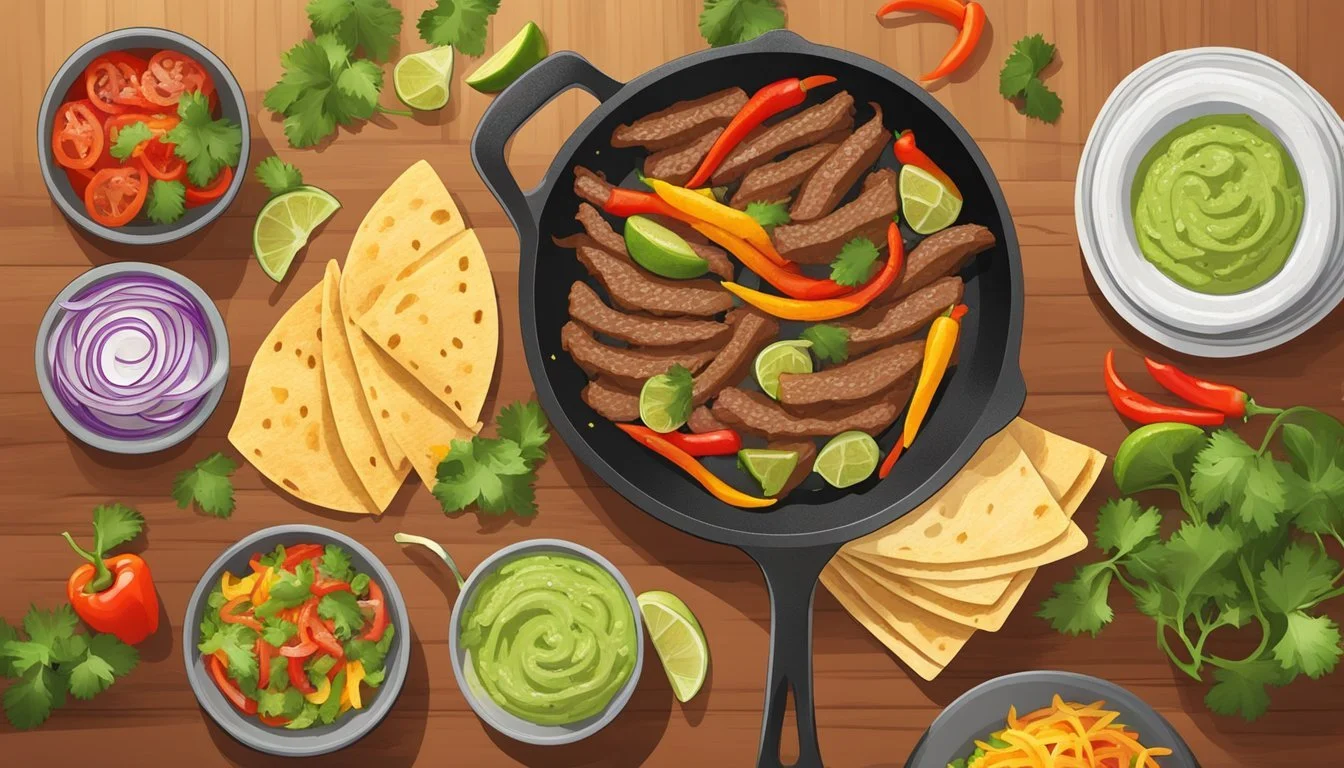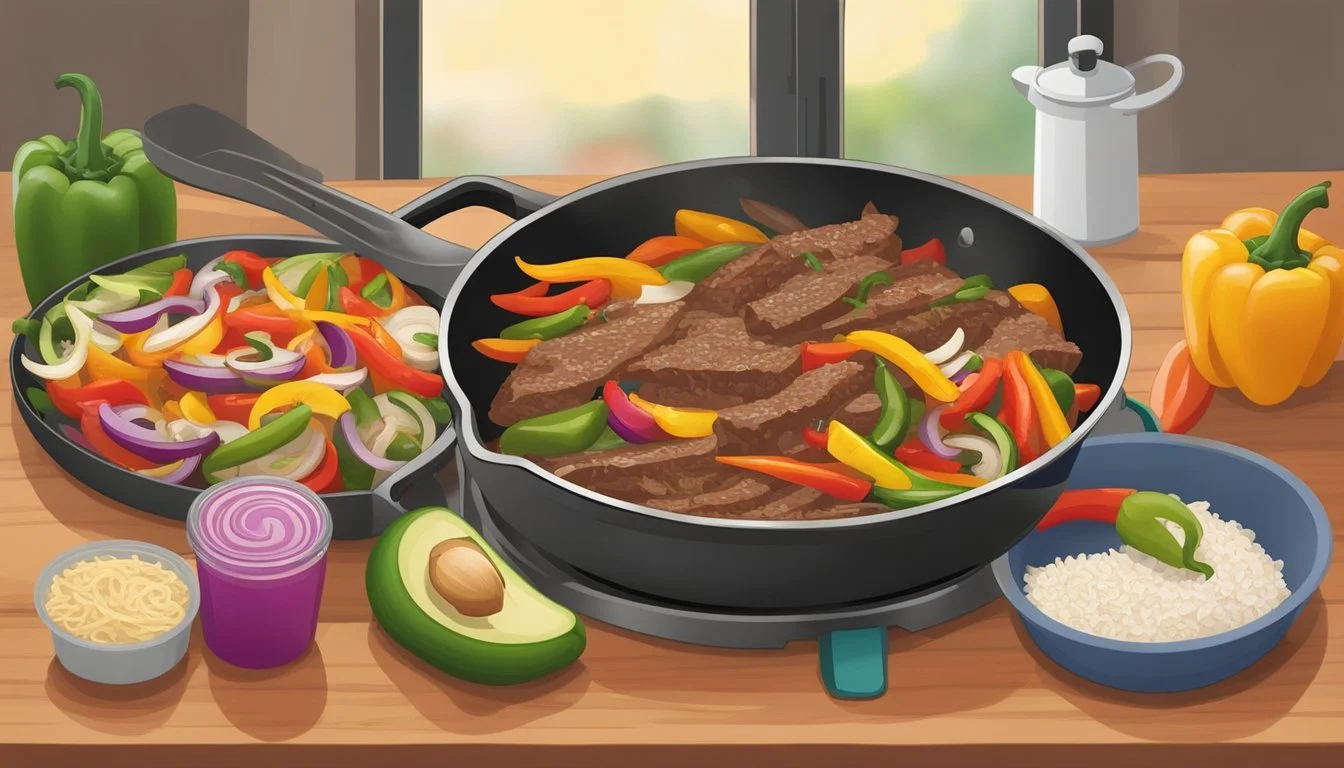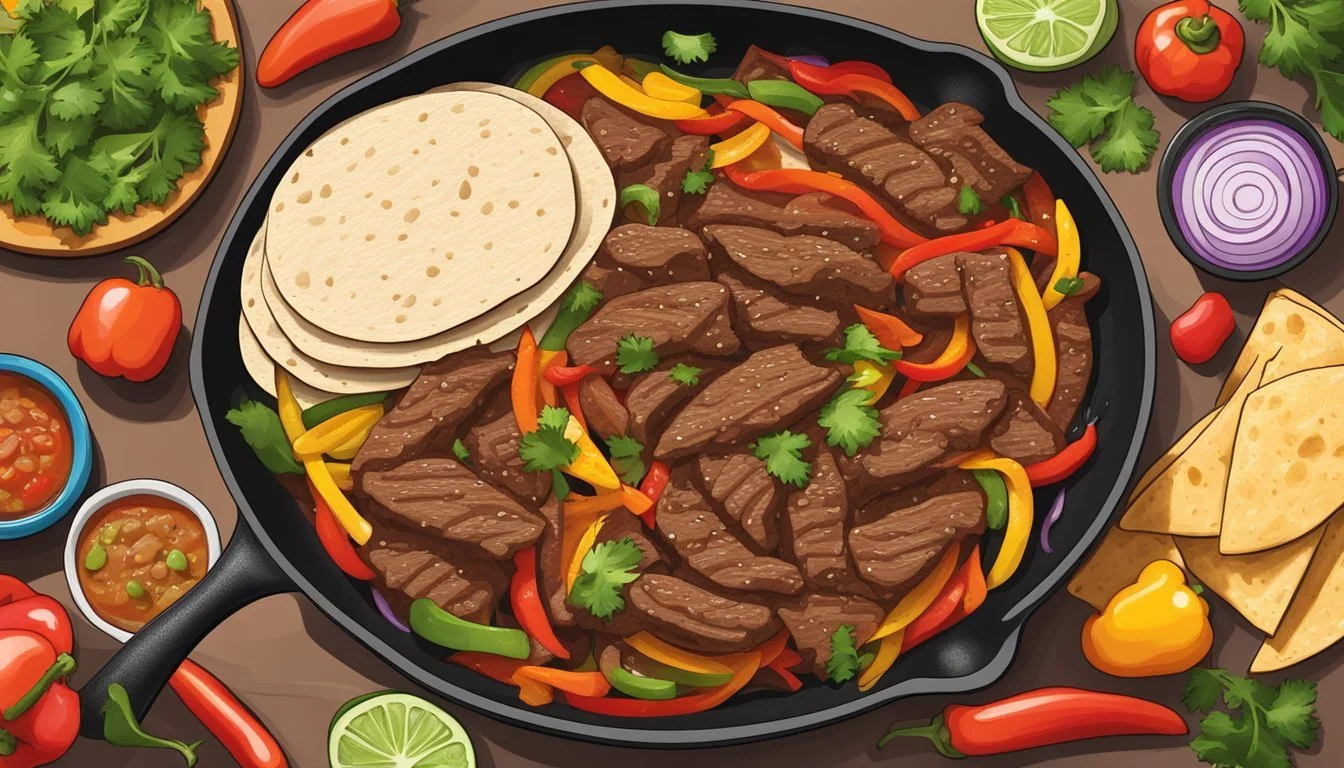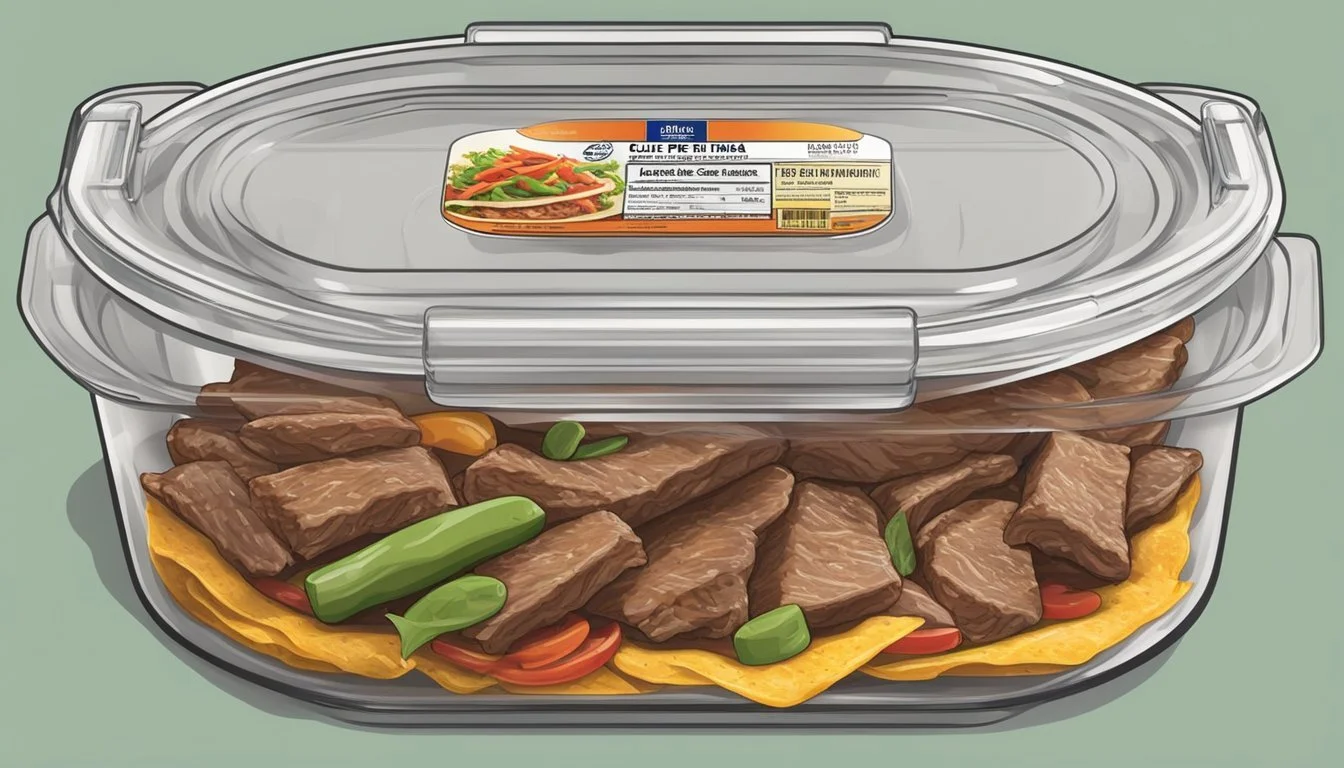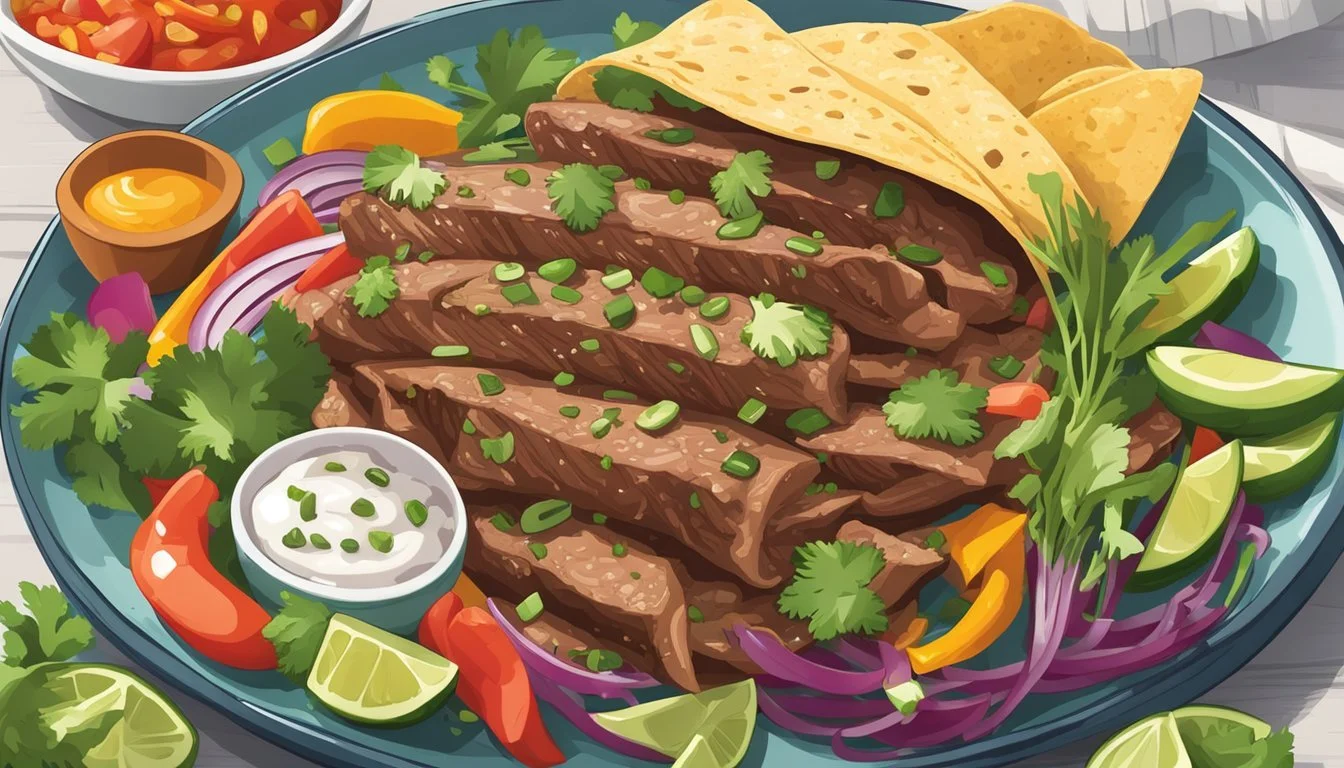How Long Do Gluten-Free Beef Fajitas Last?
Storage Tips and Shelf Life
Storing gluten-free beef fajitas properly can ensure a delicious meal even days after they've been prepared. If kept in an airtight container in the refrigerator, gluten-free beef fajitas can typically last for up to 3-4 days.
For longer storage, freezing is an excellent option. The beef fajitas can last up to three months in the freezer if properly sealed, providing a convenient and tasty meal that just needs a quick reheat.
Knowing how to store these fajitas not only extends their shelf-life but also ensures that the flavors remain intact, offering a quick and satisfying meal option for busy days.
Understanding Gluten-Free Beef Fajitas
Gluten-free beef fajitas offer a delicious and safe option for those with gluten sensitivities. These fajitas focus on specific ingredients and preparation methods to ensure they remain free from gluten.
Defining Gluten-Free
A gluten-free diet excludes the protein gluten, found in wheat, barley, rye, and related grains. Consuming gluten can cause adverse reactions in individuals with celiac disease or gluten sensitivity.
Gluten-free beef fajitas use ingredients that naturally do not contain gluten, such as beef, vegetables, and certain spices. It's crucial to ensure all components, including seasonings and tortillas, are certified gluten-free to avoid cross-contamination.
Key Ingredients in Beef Fajitas
Beef: Common cuts include flank steak or skirt steak. It's important to marinate the beef with gluten-free seasonings to enhance flavor without risking gluten contamination.
Peppers and Onions: Bell peppers and onions are essential for adding color and flavor. These vegetables are naturally gluten-free and can be seasoned with gluten-free spices.
Spices: Essential spices include cumin, chili powder, and garlic powder. Ensure these are labeled gluten-free to avoid cross-contamination.
Gluten-Free Tortillas: Traditional flour tortillas contain gluten. Alternative options include corn tortillas or other gluten-free versions.
By carefully selecting and preparing each ingredient, you can create a safe and tasty gluten-free beef fajita dish.
Preparation and Cooking Guidelines
Preparing gluten-free beef fajitas involves selecting the right cut of beef, properly marinating the meat, and cooking both the beef and vegetables to perfection. Attention to detail in these steps ensures a delicious and safe gluten-free meal.
Selecting the Right Cut of Beef
For gluten-free beef fajitas, flank steak and skirt steak are the most recommended cuts. These cuts have a rich flavor and a tender texture when cooked properly. Flank steak is slightly leaner, while skirt steak has more marbling, contributing to its robust flavor.
When choosing your cut, ensure the meat is fresh and has a deep red color. Avoid any cuts with excessive fat or gristle.
Marinating the Beef
Marinating is crucial for enhancing the flavor of the beef. A simple, yet effective marinade can be made using lime juice, garlic powder, cumin, chili powder, and salt. This mixture not only seasons the meat but also helps in tenderizing it.
Place the meat in a large resealable bag or a shallow dish, then pour the marinade over it. Ensure the beef is fully coated and let it marinate in the refrigerator for at least 30 minutes to one hour. For maximum flavor, marinate overnight.
Cooking Beef and Veggies
In a skillet over medium heat, add a drizzle of olive oil. Once heated, place the marinated beef in the skillet. Depending on the preferred doneness, cook for about 3-4 minutes per side for medium-rare or longer if desired.
After cooking the beef, let it rest for a few minutes before slicing it against the grain. In the same skillet or a clean one, add more olive oil and cook sliced bell peppers and onions until they are tender and slightly caramelized.
Always ensure the veggies are sautéed properly to complement the beef's flavors, and combine them just before serving.
Crafting the Perfect Gluten-Free Fajita
Creating gluten-free beef fajitas involves careful assembly and thoughtful seasoning. Each element, from the beef to the toppings, plays a crucial role in achieving the perfect bite.
Assembling Gluten-Free Fajitas
Start with quality gluten-free tortillas. Warm them slightly on a skillet to make them pliable. For the beef, flank or skirt steak works well. Slice the beef thinly and cook it with a bit of oil in a skillet until it reaches the desired tenderness.
For toppings, offer a variety such as sour cream, cheese, avocado, or guacamole for creaminess. Add salsa and lettuce for a fresh crunch. Lime wedges can be an excellent addition to squeeze over for extra zest.
Choosing the Right Seasonings
Using the right seasonings is essential for flavorful fajitas. A homemade fajita seasoning can include cumin, chili powder, cayenne, salt, and black pepper. Adjust the spice level according to your preference.
Marinate the beef with these seasonings along with some lime juice for at least 30 minutes before cooking. This helps to tenderize the beef and infuse it with flavors. Ensure that all seasonings used are certified gluten-free to avoid cross-contamination.
Including fresh herbs like cilantro can also enhance the dish. Cooking the beef with onions and bell peppers adds depth of flavor and texture, making the fajitas even more enjoyable.
Storing and Shelf Life of Beef Fajitas
Proper storage of gluten-free beef fajitas can ensure they remain safe to consume while retaining their flavor and texture. Key considerations include appropriate refrigeration, freezing, and identifying signs of spoilage.
Refrigeration and Freezing Guidelines
To maximize the shelf life of beef fajitas, store them in the refrigerator at 40°F (4.4°C) or below. It is best to consume refrigerated fajitas within 3 to 5 days to ensure optimal freshness and safety.
For longer storage, freezing is effective. Place the fajitas in airtight containers or heavy-duty freezer bags. Frozen fajitas can be kept for up to 2 months. When ready to eat, thaw them in the refrigerator before reheating thoroughly.
Proper storage also involves separating raw ingredients from cooked leftovers to avoid cross-contamination. Labeling containers with dates helps track their storage duration and ensures they are used within safe periods.
Identifying Spoilage Signs
Detecting spoilage in beef fajitas is crucial to prevent foodborne illnesses. Look for changes in color, texture, and smell. Spoiled beef often has an off-putting odor and a slimy texture, indicating bacterial growth.
Another sign of spoilage is discoloration. Fresh beef should be a vibrant red or pink; a brownish or grayish tint suggests it is past its prime. Additionally, visible mold or unusual spots on the beef or vegetables signal that the fajitas should not be consumed.
Regularly inspect stored fajitas and discard any that show signs of spoilage to maintain food safety standard. Relying on these indicators helps ensure that your fajitas remain enjoyable and safe to eat.
Nutritional Information
Gluten-free beef fajitas offer a balanced profile of macronutrients and essential vitamins and minerals. They typically provide a good source of protein and healthy fats, along with valuable micronutrients that support overall health.
Macronutrient Profile
Gluten-free beef fajitas are rich in protein, essential for muscle repair and growth. A typical serving can contain around 20-25 grams of protein, depending on the beef cut and portion size.
They also include healthy fats, particularly when using olive oil. A serving might have 10-15 grams of total fat, with a portion of this being saturated fat, around 4-5 grams.
Carbohydrates mainly come from vegetables and any gluten-free tortillas used, generally adding up to 20-30 grams of carbs per serving. The high fiber content from veggies contributes roughly 3-5 grams, aiding digestion.
Vitamins and Minerals
Beef fajitas provide a significant amount of iron, essential for oxygen transport in the blood. One serving typically offers about 15-20% of the daily iron requirement.
They are also a good source of Vitamin A and Vitamin C due to the bell peppers, with each serving providing approximately 30-40% of daily Vitamin A and 50-70% of daily Vitamin C.
Other key minerals include calcium and potassium. One serving can offer about 8-10% of daily calcium needs and around 10-12% of daily potassium needs, contributing to bone health and proper muscle function.
Fajitas also contain moderate levels of sodium, primarily from seasoning. It can range from 300-500 milligrams per serving, which is important to keep in mind for those monitoring their sodium intake.
Incorporating these fajitas into a balanced diet can help meet various nutritional needs efficiently.
Serving and Presentation Suggestions
Enhancing your gluten-free beef fajitas with the right accompaniments and garnishes can elevate the dish, adding vibrant flavors and a visually appealing presentation.
Accompaniments and Side Dishes
Serve gluten-free beef fajitas with warm corn tortillas. These tortillas provide a soft and slightly sweet complement to the seasoned steak.
Rice is a popular side dish; consider Mexican rice cooked with tomatoes and spices. A side of black or pinto beans adds protein and a creamy texture.
Include a fresh salad with lettuce, tomatoes, and avocados. These ingredients add crunch and a cool contrast.
For extra flavor, offer a side of lime wedges for squeezing over the fajitas. The acidity cuts through the richness of the beef.
Garnishing for Enhanced Flavor
Garnishing your fajitas can enhance both flavor and presentation. Fresh cilantro should be generously sprinkled over the top to add a burst of freshness and green color.
Include sliced jalapeños for those who enjoy a spicy kick.
Dollops of sour cream provide a creamy contrast and coolness.
A generous scoop of guacamole sits well on the side, adding richness and a buttery texture.
Top the fajitas with diced onions and tomatoes for crunch, and consider some shredded cheese for an optional, extra layer of flavor.
All these elements work together to create a balanced and enticing dish.
Various Ways to Enjoy Beef Fajitas
Beef fajitas offer numerous options for personalization, allowing for different dietary needs and preferences, such as gluten-free, dairy-free, and paleo. The versatility of this dish makes it perfect for both traditional methods and modern twists.
Traditional and Modern Twists
Traditional beef fajitas are often made with marinated flank steak, bell peppers, and sweet onions, all cooked together and served on warm tortillas. A classic recipe usually includes cumin, chili powder, and sea salt for seasoning.
Modern twists can include grilling the fajitas for an enhanced smoky flavor or using a slow cooker for a tender, hands-off approach. Organic ingredients can elevate the dish while ensuring a healthier meal. For a paleo-friendly version, swap tortillas for lettuce wraps and ensure all seasonings are free from added sugar.
Tips for Customizing Your Fajitas
Customizing beef fajitas can make them more enjoyable for different tastes and dietary needs.
For a dairy-free option, omit cheese and sour cream, instead using fresh pico de gallo and avocado. Spice levels can be adjusted by varying the amount of cayenne and red pepper flakes used. Adding a squeeze of lime can brighten the flavors without adding unwanted calories.
Using a combination of colored bell peppers can add visual appeal and varied flavors. For a quick meal, pre-slice all vegetables and store them in the refrigerator, ready to just toss into the pan or grill. Add different toppings, such as shredded lettuce, black beans, or corn, to suit family preferences.


